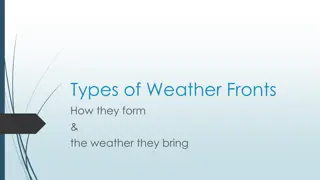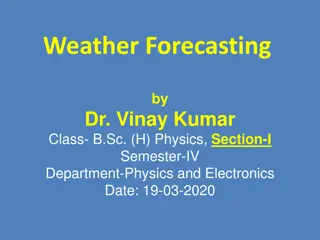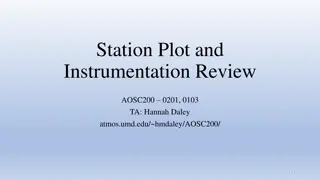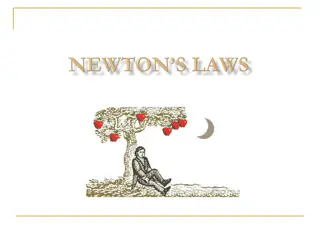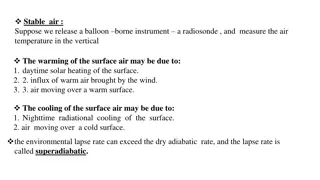Understanding Atmospheric Forces and Their Impacts on Weather
Explore the intricate relationship between wind patterns, hydrostatic balance, pressure gradient forces, Coriolis forces, and their effects on atmospheric dynamics. Discover how these key forces interact to shape weather patterns around the globe, from wind direction to air parcel movement and pressure differentials.
Download Presentation

Please find below an Image/Link to download the presentation.
The content on the website is provided AS IS for your information and personal use only. It may not be sold, licensed, or shared on other websites without obtaining consent from the author. Download presentation by click this link. If you encounter any issues during the download, it is possible that the publisher has removed the file from their server.
E N D
Presentation Transcript
HYDROSTATIC RELATIONSHIP 700 mb 800 mb 900 mb Upward pressure gradient force (PGF) is balanced by gravity (g).
HYDROSTATIC RELATIONSHIP Despite very strong vertical pressure gradients, vertical winds (rising and sinking air) are generally weak.
Pressure Gradient Force 4 mb/100 km
PGF = Pressure Gradient Force close isobar spacing, strong PGF farther spacing, weak PGF
Coriolis Force
Coriolis Force In the Northern Hemisphere, the Coriolis force causes an air parcel to deflect TO ITS RIGHT (to the right of its direction of motion). This deflection increases toward the North Pole.
Variation of Coriolis Force with Speed and Latitude Stronger wind speed = stronger Coriolis force
REVIEW OF KEY FORCES Pressure gradient force (PGF) High to Low Perpendicular to the isobars Proportional to isobar spacing Coriolis force (COR) Acts to right of parcel direction in N. Hemisphere (and to left in S. Hemisphere) Maximum at poles, zero at equator Proportional to wind speed (Chap. 8, pp. 210 214)
EVSC 3300 Atmosphere and Weather (3 credits) MWF, 10-10:50 a.m. EVSC 3301 (1 credit lab. optional for non- majors) Prerequisite: one semester of calculus
Geostationary Satellite Same orbital period as Earth and in same direction
Polar-orbiting Satellites 700-800 km elevation. Passes each location at same time of day
GLOBAL WINDS (Chapter 10)
Names of Latitude Bands
Non-Rotating Homogeneous Planet surface wind follows PGF
Rotating Homogeneous Planet
Columbus First Voyage (149293) Mid-latitude Westerlies
Average Precipitation Variation by Latitude (Chap. 10, pp. 266 274)
Quick SummaryLarge-scale Winds (Chapter 10): Large-scale prevailing winds vary by latitude about every 30 degrees. The Hadley Cell is a very persistent feature associated with rising air at the equator, sinking air at 30 , and easterly trade winds at the surface from 0 30 in each hemisphere. The latitude zone from 30 60 has prevailing westerly winds. Polar latitudes have highly variable winds that tend to be easterly, with cold, high pressure systems over the poles. This simple, zonal (west east) wind pattern is altered by the presence of coasts, continents, and mountain ranges.
CYCLONES AND ANTICYCLONES
Geostrophic Wind PH = PGF; C = COR
Geostrophic Wind As PGF increases, geostrophic wind speed increases.
(or low heights) Westerlies Aloft (or high heights) (or low heights)
Gradient Wind PGF = pressure gradient force CF = Coriolis force
Gradient Wind If PGF=COR, wind is not parallel to isobars If PGF>COR, gradient wind is parallel to isobars
Gradient Wind If PGF=COR, wind is not parallel to isobars If PGF<COR, gradient wind is parallel to isobars
Gradient Wind (Aside: Net = inward force minus outward force = centripetal acceleration)
Summary of Winds at Surface and Aloft Aloft (no friction) Gradient Gradient Geostrophic Surface (with friction)
Buys-Ballots Law If wind is at your back, low pressure is to your left.
Cyclones and Anticyclones Surface friction produces surface convergence and divergence.
Southern Hemisphere Winds at Surface and Aloft Cor Trough Ridge PGF
S. Hemisphere Surface Map
Cyclones Southern Hemisphere Northern Hemisphere (Chap. 8, pp. 214 224)
Quick SummaryCyclones and Anticyclones (Chap. 8): Geostrophic Wind (straight isobars, no friction) balance between PGF and COR wind is parallel to isobars Gradient Wind (curved isobars, no friction) inward force > outward force wind is parallel to isobars around a curved path cyclonic flow is counter-clockwise in N. Hemisphere and clockwise in S. Hemisphere Surface Wind (friction is present) friction reduces wind speed slower wind reduces COR flow is across the isobars toward low pressure more friction increases cross-isobaric flow














